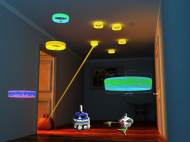Swarmanoid project – robots work like swarmed insects
 We already wrote about modular and shape-shifting robots in our previous articles. Swarm robotics is inspired by the social insect behavior, and emphasizes aspects such as decentralization of control, limited communication abilities among robots, use of local information, emergence of global actions, and robustness. Most current studies in swarm robotic systems have focused on robotic swarms, in which individuals are physically and behaviorally undifferentiated, however, the Swarmanoid project proposes a different approach to build robots that can successfully and adaptively act in human made environments.
We already wrote about modular and shape-shifting robots in our previous articles. Swarm robotics is inspired by the social insect behavior, and emphasizes aspects such as decentralization of control, limited communication abilities among robots, use of local information, emergence of global actions, and robustness. Most current studies in swarm robotic systems have focused on robotic swarms, in which individuals are physically and behaviorally undifferentiated, however, the Swarmanoid project proposes a different approach to build robots that can successfully and adaptively act in human made environments.
The main scientific objective of the proposed research is the design, implementation and control of a novel distributed robotic system made of heterogeneous, dynamically connected small autonomous robots in order to form a swarmanoid. The swarmanoid that they intend to build will be comprised of numerous (about 60) autonomous robots of three types: eye-bots, hand-bots, and foot-bots.
Eye-bots are specialized in sensing and analyzing the environment from a high position to provide an overview that foot-bots or hand-bots cannot have. They are based on the familiar quad-rotor helicopter design, with an extra feature – the ability to stick to ceilings. That gives Eyebot the ability to linger indefinitely in advantageous positions while providing surveillance with a pan and tilt camera system. It can autonomously attach and detach itself from ceilings, and uses simple optical flow analysis to detect drift and infrared sensors to avoid obstacles.
Hand-bots are specialized in moving and acting in a space zone between the one covered by the foot-bots (the ground) and the one covered by the eye-bots (the ceiling). Hand-bots can climb vertical surfaces of walls or objects located in the environment. It’s not quite strong enough to climb using just its grippers and arm, so it has a magnetic rope launcher that can fire up to the ceiling in order to carry most of its weight.
Foot-bots are specialized in moving on rough terrain and transporting either objects or other robots. They are based on the robotic platform developed within the European Swarm-bots project. Footbot can be used in order to carry other bots and manipulate the objects on the ground. It is based on the marXbot design, which brought interesting elements as: hot swappable battery, mechanical and electronic modularity, high computational power including float processing, improved sensing ability for environment and inter-robot detection and simpler construction and maintenance.
The biggest advantage of this system is that you can easily replace or upgrade any module (robot) in the swarm. And, unlike non-modular robots, if any component fails, the swarm’s overall performance is mostly unaffected. The research will also contribute to the development of distributed algorithms meant for control of the swarmanoid and the study and definition of distributed communication protocols, thus making this and similar future projects more nimble and practical.









Leave your response!